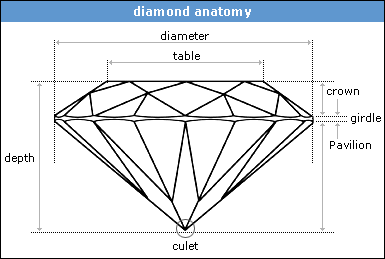
© 2009 Robere's Jewelry. All Rights Reserved. Website Design by Piroozp.
Many gemologists consider cutting quality to be the most important diamond characteristic because even if a diamond has perfect color and clarity, a diamond with a poor cut will have reduced brilliance. Cut is not shape, ie, pear, round, oval. Cut refers to the quality of the proportioning, polish, and symmetry.
The cut of a diamond—its roundness, its depth and width, and the uniformity of the facets—all determine a diamond's ability to exhibit brilliance.
The diamond's anatomy diagram below shows the properties of the diamond mentioned.

The width of the diamond as measured through the girdle.
The flat top and largest facet of a gemstone.
The top portion of a diamond extending from the girdle to the table.
The narrow band around the widest part of a diamond.
The bottom portion of a diamond, extending from the girdle to the point of the stone.
The facet at the tip of a gemstone. The preferred culet is not visible with the unaided eye (graded "medium" or "none")
The height of a gemstone measured from the culet to the table.
The flat top and largest facet of a gemstone.
The top portion of a diamond extending from the girdle to the table.
The narrow band around the widest part of a diamond.
The bottom portion of a diamond, extending from the girdle to the point of the stone.
The facet at the tip of a gemstone. The preferred culet is not visible with the unaided eye (graded "medium" or "none")
The height of a gemstone measured from the culet to the table.
Diameter:
Table:
Crown:
Girdle:
Pavilion:
Culet:
Depth:
Table:
Crown:
Girdle:
Pavilion:
Culet:
Depth:
Generally speaking, there is some agreement on how round brilliant-cut diamonds should be cut to optimize brilliance and dispersion. However, there is no universal standard as to what constitutes the "ultimate" or "perfect" proportions for a round brilliant. This is a current area of research for the diamond industry.
The width and depth have the greatest effect on how light travels within the diamond, and how it exits in the form of brilliance. As cutting quality can be a confusing subject, please ask our quality professionals, at Roberes, about ideal proportions, and we will be happy to guide you through it.
The width and depth have the greatest effect on how light travels within the diamond, and how it exits in the form of brilliance. As cutting quality can be a confusing subject, please ask our quality professionals, at Roberes, about ideal proportions, and we will be happy to guide you through it.
